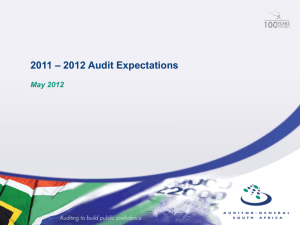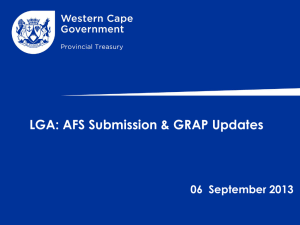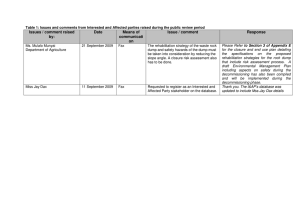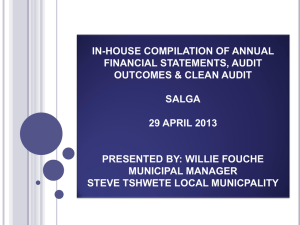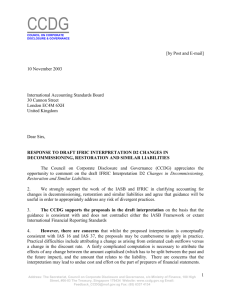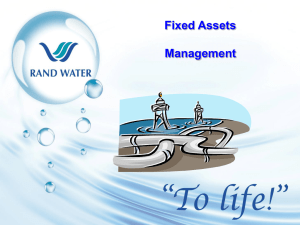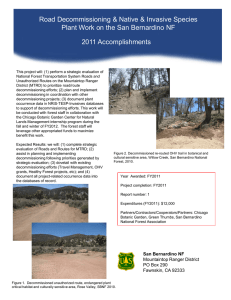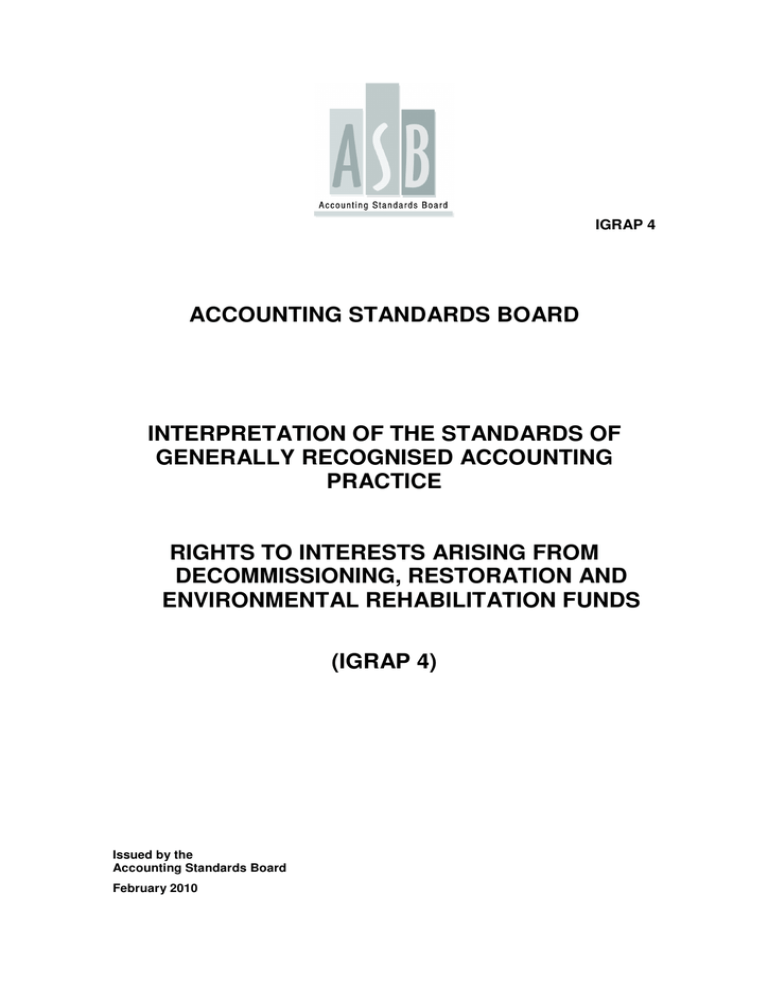
IGRAP 4
ACCOUNTING STANDARDS BOARD
INTERPRETATION OF THE STANDARDS OF
GENERALLY RECOGNISED ACCOUNTING
PRACTICE
RIGHTS TO INTERESTS ARISING FROM
DECOMMISSIONING, RESTORATION AND
ENVIRONMENTAL REHABILITATION FUNDS
(IGRAP 4)
Issued by the
Accounting Standards Board
February 2010
IGRAP 4
Acknowledgement
This Interpretation of the Standards of Generally Recognised Accounting Practice (IGRAP)
is drawn primarily from the equivalent Interpretation of the International Financial
Reporting Standard on Rights to Interests Arising from Decommissioning, Restoration and
Environmental Rehabilitation Funds (IFRIC 5) issued by the International Financial
Reporting Interpretations Committee (IFRIC) of the International Accounting Standards
Board (IASB). The IASB has issued a comprehensive body of IFRICs. Extracts of the
IFRIC on Rights to Interests Arising from Decommissioning, Restoration and
Environmental Rehabilitation Funds are reproduced in these Interpretations of the
Standards of GRAP with the permission of the IASB.
The approved text of IFRSs is that published by the IASB in the English language and
copies may be obtained from:
IASB Publications department
7th floor, 166 Fleet Street
London ED4A 2DY
United Kingdom
Internet: http://www.iasb.org.uk
Copyright on IFRSs, interpretations, exposure drafts and other publications of the IASB
are vested in the International Accounting Standards Committee Foundation (IASCF) and
terms and conditions attached should be observed.
Accounting Standards Board
P O Box 74129
Lynnwood Ridge
0040
Copyright ©2010 by the Accounting Standards Board
All rights reserved. No part of this publication may be reproduced, stored in a retrieval
system, or transmitted, in any form or by any means, electronic, mechanical,
photocopying, recording, or otherwise, without the prior permission of the Accounting
Standards Board.
Permission to reproduce limited extracts from the publication will not usually be withheld.
Issued February 2010
2
Rights to Interests Arising from
Decommissioning, Restoration and
Environmental Rehabilitation Funds
IGRAP 4
RIGHTS
TO
INTERESTS
ARISING
FROM
DECOMMISSIONING,
RESTORATION AND ENVIRONMENTAL REHABILITATION FUNDS
Introduction
Interpretations of the Standards of Generally Recognised Accounting
Practice
The Accounting Standards Board (Board) is required in terms of the Public Finance
Management Act, Act No. 1 of 1999, as amended (PFMA), to determine generally
recognised accounting practice referred to as Standards of Generally Recognised
Accounting Practice (GRAP).
The Board must determine GRAP for:
(a)
departments (national and provincial);
(b)
public entities;
(c)
constitutional institutions;
(d)
municipalities and boards, commissions, companies, corporations, funds or other
entities under the ownership control of a municipality; and
(e)
Parliament and the provincial legislatures.
The above are collectively referred to as “entities”.
The Board has approved the application of Statements of Generally Accepted Accounting
Practice (GAAP), codified by the Accounting Practices Board (APB) and issued by the
South African Institute of Chartered Accountants (SAICA) to be GRAP for:
(a)
government business enterprises (GBEs)(as defined in the PFMA);
(b)
trading entities (as defined in the PFMA);
(c)
any other entity, other than a municipality, whose ordinary shares, potential
ordinary shares or debt are publicly traded on the capital markets; and
(d)
entities under the ownership control of any of these entities.
The Board believes that Statements of GAAP are relevant and applicable to financial
statements prepared by all such entities including those under their ownership control.
Financial statements should be described as complying with Standards of GRAP only if
they comply with all the requirements of each applicable Standard of GRAP and any
related Interpretations of the Standards of GRAP.
Issued February 2010
3
Rights to Interests Arising from
Decommissioning, Restoration and
Environmental Rehabilitation Funds
IGRAP 4
Any limitation of the applicability of specific Standards or Interpretations of the Standards
of GRAP is made clear in those Standards or Interpretations of the Standards of GRAP.
The Interpretation of the Standard of GRAP on Rights to Interests Arising from
Decommissioning, Restoration and Environmental Rehabilitation Funds is set out in
paragraphs .01 to .16. All paragraphs in this Interpretation of the Standards of GRAP have
equal authority. The status and authority of appendices are dealt with in the preamble to
each appendix. This Interpretation of the Standards of GRAP should be read in the context
of its objective, its basis for conclusions if applicable, the Preface to Standards of GRAP,
the Preface to the Interpretations of the Standards of GRAP and the Framework for the
Preparation and Presentation of Financial Statements.
Standards of GRAP and Interpretations of Standards of GRAP should also be read in
conjunction with any directives issued by the Board prescribing transitional provisions, as
well as any regulations issued by the Minister of Finance regarding the effective dates of
the Standards of GRAP, published in the Government Gazette.
Reference may be made to a Standard of GRAP that has not been issued at the time of
issue of this Interpretation of the Standards of GRAP. This is done to avoid having to
change the Standards already issued when a later Standard is subsequently issued.
Paragraph .12 of the Standard of GRAP on Accounting Policies, Changes in Accounting
Estimates and Errors provides a basis for selecting and applying accounting policies in the
absence of explicit guidance.
Issued February 2010
4
Rights to Interests Arising from
Decommissioning, Restoration and
Environmental Rehabilitation Funds
IGRAP 4
Interpretation of the Standards of GRAP on Rights to Interests Arising
from Decommissioning, Restoration and Environmental Rehabilitation
Funds
References
•
GRAP 3 Accounting Policies, Changes in Accounting Estimates and Errors (as
revised in 2010)
•
GRAP 6 Consolidated and Separate Financial Statements
•
GRAP 7 Investments in Associates
•
GRAP 8 Interests in Joint Ventures
•
GRAP 19 Provisions, Contingent Liabilities and Contingent Assets (as revised in
2010)
•
GRAP 104 Financial Instruments
•
IGRAP 11 Consolidation – Special Purpose Entities
Background
.01
The purpose of decommissioning, restoration and environmental rehabilitation
funds, hereafter referred to as ‘decommissioning funds’ or ‘funds’, is to segregate
assets to fund some or all of the costs of decommissioning plant (such as a
nuclear plant) or certain equipment (such as motor vehicles), or in undertaking
environmental rehabilitation (such as rectifying pollution of water), together
referred to as ‘decommissioning’.
.02
Contributions to these funds may be voluntary or required by regulation or law.
The funds may have one of the following structures:
(a) Funds that are established by a single contributor to fund its own
decommissioning obligations, whether for a particular site, or for a number of
geographically dispersed sites.
(b) Funds that are established with multiple contributors to fund their individual or
joint decommissioning obligations, when contributors are entitled to
reimbursement for decommissioning expenses to the extent of their
contributions plus any actual earnings on those contributions less their share
of the costs of administering the fund. Contributors may have an obligation to
make additional contributions, for example, in the event of the liquidation of
another contributor.
Issued February 2010
5
Rights to Interests Arising from
Decommissioning, Restoration and
Environmental Rehabilitation Funds
IGRAP 4
(c) Funds that are established with multiple contributors to fund their individual or
joint decommissioning obligations when the required level of contributions is
based on the current activity of a contributor and the benefit obtained by that
contributor is based on its past activity. In such cases there is a potential
mismatch in the amount of contributions made by a contributor (based on
current activity) and the value realisable from the fund (based on past activity).
.03
Such funds generally have the following features:
(a) The fund is separately administered by independent trustees.
(b) Entities (contributors) make contributions to the fund, which are invested in a
range of assets that may include both debt and equity investments, and are
available to help pay the contributors’ decommissioning costs. The trustees
determine how contributions are invested, within the constraints set by the
fund’s governing documents and any applicable legislation or other
regulations.
(c) The contributors retain the obligation to pay decommissioning costs. However,
contributors are able to obtain reimbursement of decommissioning costs from
the fund up to the lower of the decommissioning costs incurred and the
contributor’s share of assets of the fund.
(d) The contributors may have restricted access or no access to any surplus of
assets of the fund over those used to meet eligible decommissioning costs.
Scope
.04
This Interpretation of the Standards of GRAP applies to accounting in the financial
statements of a contributor for interests arising from decommissioning funds that
have both of the following features:
(a) the assets are administered separately (either by being held in a separate
legal entity or as segregated assets within another entity); and
(b) a contributor’s right to access the assets is restricted.
.05
A residual interest in a fund that extends beyond a right to reimbursement, such as
a right to distributions once all the decommissioning has been completed or on
winding up the fund, may be an equity instrument within the scope of the Standard
of GRAP on Financial Instruments and is not within the scope of this Interpretation
of the Standards of GRAP.
Issues
.06
The issues addressed in this Interpretation of the Standards of GRAP are:
Issued February 2010
6
Rights to Interests Arising from
Decommissioning, Restoration and
Environmental Rehabilitation Funds
IGRAP 4
(a) how should a contributor account for its interest in a fund?
(b) when a contributor has an obligation to make additional contributions, for
example, in the event of the liquidation of another contributor, how should that
obligation be accounted for?
Consensus
Accounting for an interest in a fund
.07
The contributor shall recognise its obligation to pay decommissioning costs as
liability and recognise its interest in the fund separately unless the contributor is
not liable to pay decommissioning costs even if the fund fails to pay.
.08
The contributor shall determine whether it has control, joint control or significant
influence over the fund by reference to the Standards of GRAP on Consolidated
and Separate Financial Statements, Investments in Associates, Interests in Joint
Ventures and IGRAP 11 Consolidation – Special Purpose Entities. If it does, the
contributor shall account for its interest in the fund in accordance with those
Standards of GRAP and Interpretation of the Standards of GRAP.
.09
If a contributor does not have control, joint control or significance influence over
the fund, the contributor shall recognise the right to receive reimbursement from
the fund as a reimbursement in accordance with the Standard of GRAP on
Provisions, Contingent Liabilities and Contingent Assets (as revised in 2010). This
reimbursement shall be measured at the lower of:
(a) the amount of the decommissioning obligation recognised; and
(b) the contributor’s share of the fair value of the net assets of the fund
attributable to contributors.
Changes in the carrying value of the right to receive reimbursement other than
contributions to and payments from the fund shall be recognised in surplus or
deficit in the period in which these changes occur.
Accounting for obligations to make additional contributions
.10
When a contributor has an obligation to make potential additional contributions, for
example, in the event of the liquidation of another contributor or if the value of the
investment assets held by the fund decreases to an extent that they are insufficient
to fulfil the fund’s reimbursement obligations, this obligation is a contingent liability
that is within the scope of the Standard of GRAP on Provisions, Contingent
Liabilities and Contingent Assets (as revised in 2010). The contributor shall
recognise a liability only if it is probable that additional contributions will be made.
Issued February 2010
7
Rights to Interests Arising from
Decommissioning, Restoration and
Environmental Rehabilitation Funds
IGRAP 4
Disclosure
.11
A contributor shall disclose the nature of its interest in a fund and any restrictions
on access to the assets in the fund.
.12
When a contributor has an obligation to make potential additional contributions that
is not recognised as a liability (see paragraph .10), it shall make the disclosures
required by paragraph .95 of the Standard of GRAP on Provisions, Contingent
Liabilities and Contingent Assets (as revised in 2010).
.13
When a contributor accounts for its interest in the fund in accordance with
paragraph .09, it shall make the disclosures required by paragraph .94(c) of the
Standard of GRAP on Provisions, Contingent Liabilities and Contingent Assets (as
revised in 2010).
Transitional provisions
.14
All changes resulting from the application of this Interpretation of the
Standards of GRAP shall be accounted for in accordance with the
requirements of the Standard of GRAP on Accounting Policies, Changes in
Accounting Estimates and Errors (as revised in 2010).
Effective date
Initial adoption of the Standards of GRAP
.15
This Interpretation of the Standards of GRAP becomes effective with
reference to the effective date of the applicable Standards of GRAP as
determined by the Minister of Finance in a regulation to be published in
accordance with section 91(1)(b) of the Public Finance Management Act, Act
No. 1 of 1999, as amended.
Entities already applying Standards of GRAP
.16
An entity shall apply this Interpretation of the Standards of GRAP for annual
financial statements covering periods beginning on or after 1 April 2011.
Issued February 2010
8
Rights to Interests Arising from
Decommissioning, Restoration and
Environmental Rehabilitation Funds
IGRAP 4
Comparison with the Interpretation of IFRS on Rights to Interests
arising from Decommissioning, Restoration and Environmental
Rehabilitation Funds (IFRIC 5) (December 2004)
This Interpretation of the Standards of GRAP on Rights to Interests Arising from
Decommissioning, Restoration and Environmental Rehabilitation Funds (IGRAP 4) is
drawn primarily from the Interpretation of IFRS on Rights to Interests Arising from
Decommissioning, Restoration and Environmental Rehabilitation Funds (IFRIC 5). The
main differences between this Interpretation and IFRIC 5 are as follows:
•
This Interpretation uses different terminology, in certain instances, from IFRIC 5. The
most significant examples are the use of the term “surplus or deficit”. The equivalent
term in IFRIC 5 is “profit or loss”.
Issued February 2010
9
Rights to Interests Arising from
Decommissioning, Restoration and
Environmental Rehabilitation Funds

